
Consumers
How Luxury Brands Are Reaching China’s Millennials Shoppers with Art Exhibitions
by
Jiaqi Luo | December 10, 2018
Selfie-obsessed and experience-hungry, today’s generation of young consumers are flocking to the rich and immersive expositions created by luxury brands in droves.
Between Louis Vuitton’s “Volez, Voguez, Voyage”, Gucci’s “The Artist is Present” and Prada’s Rongzhai art space, 2018 has been a busy year for Chinese fashionistas looking to keep up with the bourgeoning number of luxury brand-fronted exhibitions across the country. To put things in perspective, these are just those that made headlines in November alone.
Though luxury brands have long been patrons of contemporary art, these recent exhibits in China are a departure from brand art patronages of the past. No longer a branded display of high art curated for the elite, contemporary branded exhibits in China are now created with digital natives in mind – consumers who increasingly demand more experience from brands. In the past, exhibitions used to be about bringing legitimacy and credibility to a luxury brand, boosting its equity. Today, however, exhibitions are here to engage Chinese millennials and widen their perception of what luxury could be.
Hosting an art exhibition in China is strategic simply because it taps into specific cultural contexts. First of all, China’s digital-first social environment is taking the selfie culture to a whole other level. With many Chinese millennials having normalized this “I-post-therefore-I-am” mindset, every meal and experience needs to be photographed, edited, and documented on social media. If posting museum selfies is considered a popular thing to do all over the world, it is a must among the young in China. The Chinese term “打卡 Da ka”, which literally means “to clock in”, is frequently associated with museum selfies, likening the experience to an obligatory one.
Secondly, attending an art exhibition connotes a certain level of class in China. In the more socially rigid 20th century, many saw frequenting art spaces as a pastime of the bourgeoisie – something distinctly detached from the masses. Nowadays, while showcasing one’s appreciation for art on social media is no longer seen as a “detached” activity, the subtle connotation of one belonging to an elevated social class remains. China is also home to a different demographic of art goers than other markets. If the typical museum visitors are middle-aged couples in Western countries, those in China are novelty-loving, style-conscious millennials. Besides owning luxury products, they also want to possess experiences that are signifiers of high taste.
Let’s take a look at how three recent branded exhibits leverage China’s digital culture to make their message known:
#LouisVuittonVVVShanghai#
November 16th, 2018 through February 2nd, 2019

The best photo spots according to Louis Vuitton
Image: @Louis Vuitton’s Weibo
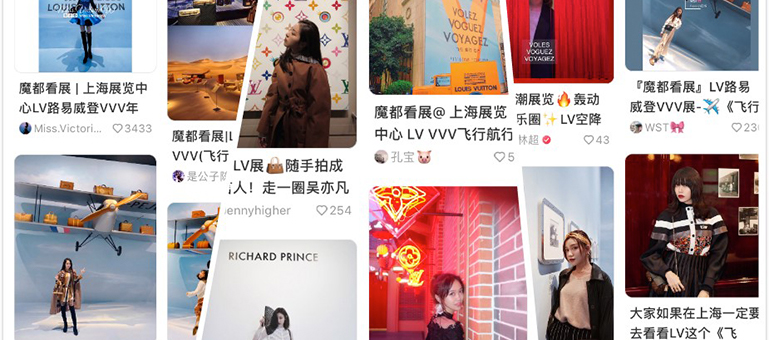
The #LouisVuittonVVV# community on RED
Image: RED (Xiao Hong Shu)
Part of a global tour, Louis Vuitton’s “Volez, Voguez, Voyage” in Shanghai stands out with its democratic digital approach that is rarely seen in the luxury world. Through collaborations with mass market Chinese lifestyle applications like MoBike (a bike sharing service) and Dianping (a popular review and rating app), Louis Vuitton invites the public to see the exhibit as part of their “top things to do” in Shanghai. This is largely in line with LVMH CFO Jean-Jacques Guiony’s comments in an interview early this year. “We are not concerned about overexposure – the risk is to lack momentum,” he said.
A Mini Program dedicated to the VVV exhibit also fuses the museum experience with social media-friendly initiatives. Besides practical information, the Mini Program also features a selfie section with specially designed Louis Vuitton-branded stickers, and a video section that allows for the production of social media-ready clips.
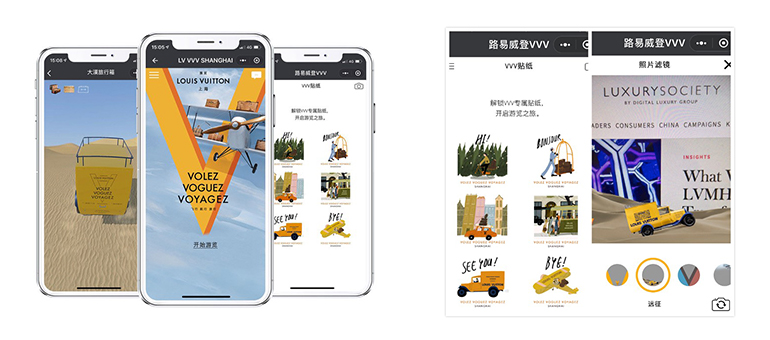
The WeChat Mini Program designed for the VVV exhibit
Image: Louis Vuitton
Gucci Exhibit “The Artist is Present”
October 11 through December 16 2018

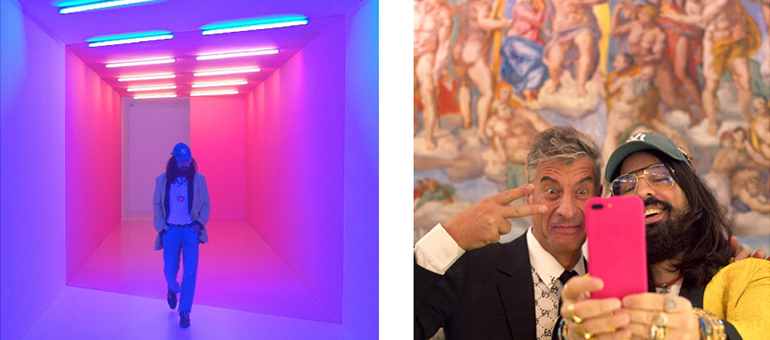
The best photo spots according to Gucci
Image: @Gucci’s Weibo
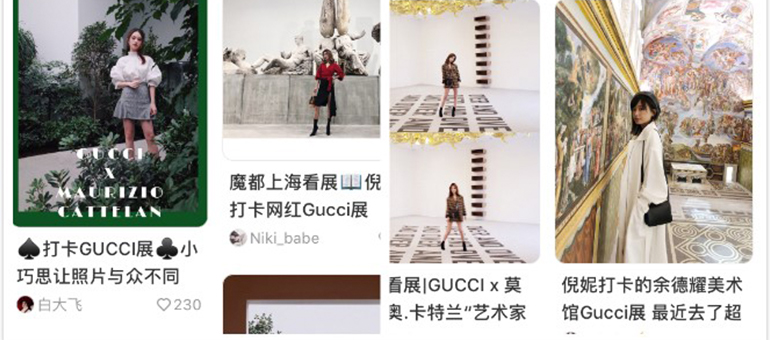
The #GucciExhibit# page on RED
Image: RED (Xiao Hong Shu)
Users on social commerce platform RED (Xiao Hong Shu) often refer to the Gucci exhibition as a “photo paradise” in their entries. To further drive this point home, Gucci’s Weibo also features chosen selfies from creative director Alessandro Michele and artist Maurizio Cattelan at the show. Equipped with immersive colors, highly Instagrammable murals, and an interesting exhibition concept of redefining originality, the Gucci exhibit meets both milllenials’ need for photos and irony.
Prada’s Rong Zhai Project
Inaugurated on October 12, 2017

Actor Mokelili posting the Prada Rongzhai visit
Image: @Mokelili’s Weibo
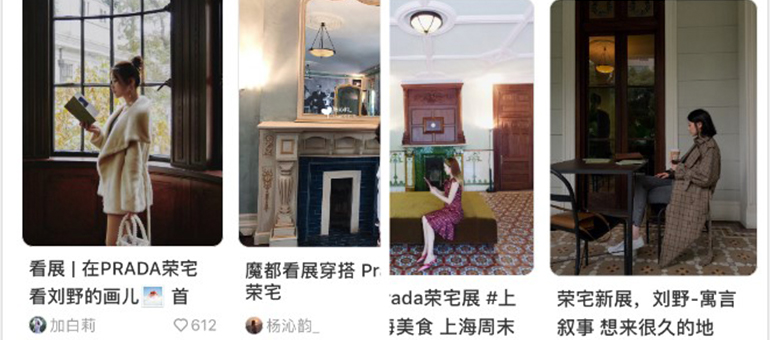
The #PradaRongzhai# page on RED
Image: RED (Xiao Hong Shu)
As Fondazione Prada’s restoration project in Shanghai, Rongzhai has gained a solid reputation among China’s fashion crowd, attracting more than 10,000 visitors since the house opened in October 2017. A trip to Prada’s Rongzhai offers one a peek into China’s top influencer circle. Fashionistas from all over the country make their way there as though it were a pilgrimage site, dressed stylishly and trailed after by a professional photographer. In fact, the #PradaRongzhai# hashtag community on RED features many instructional posts on “what to wear to a Rongzhai show”.
In the past, an exhibition might have been a brand’s marketing tool to impact the elite. But today it is an inclusive, inviting space for the public to experience the glamour before owning it. In an era where digital influence and selfie culture reign supreme, these designer art spaces increasingly resonate with the young.
1. From Storytelling to Live Experiences
In an age of attention scarcity, branded art spaces offer visitors a rare chance for story immersion, and of course, content to pepper one’s social media feed with. Storytelling alone isn’t enough for luxury houses to create a unique edge in China’s new experience economy anymore. Now, consumers want to live that story too.
2. Be as Culturally Sensitive as Possible
As the recent Dolce & Gabbana scandal revealed, displaying any kind of culturally superior attitude can lead to tragic consequences in China. As a trending comment during the D&G; social media storm describes, “you are welcome to demonstrate cultural difference, but not cultural superiority.”
3. Give Visitors Their “15 minutes of fame”
Pop artist Andy Warhol once said, "In the future, everyone will be world-famous for 15 minutes." The Chinese social media landscape today has proved Warhol’s fame theory true. In fact, Chinese consumers are constantly scouting for photo opportunities and brag-worthy experiences. With their social media-friendly visuals, these branded exhibits have provided just the right fix.
Cover Image: Louis Vuitton

